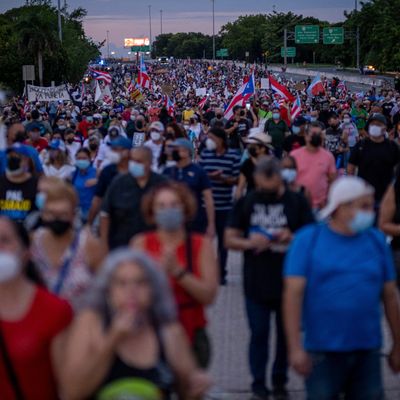
Thousands of Puerto Ricans marched down a main highway in the capital of San Juan on Friday to protest the privatization of the island’s public electricity grid, which has left them with unprecedented outages, longer than normal restoration times, and billing increases.
The large-scale protest went into the night with protesters pulling out their phones once it got dark, demanding the cancellation of the island’s 15-year contract with Luma Energy — a private company that took over the island’s transmission and distribution of electricity in June. The company was supposed to spend billions of dollars to upgrade the battered electrical grid, but month’s into Luma Energy’s takeover, the island has declared a state of emergency after a wave of rolling blackouts; at one point, a substation fire even knocked out power to 800,000 customers.
Outages aren’t only happening when power generation units break down; late last week, the private company instituted a wave of rolling blackouts that last several hours after officials warned that demand is exceeding supply. What’s more, island residents are paying higher power bills under Luma, even though they already pay twice as much as power customers in the States.
“It’s not normal to have blackouts, it’s not normal that our students cannot study properly, it’s not normal to have to live with generators, it’s not normal to have to throw away groceries because the refrigerator can’t work without power,” Ricardo Santos, a spokesperson for Todos Somos Pueblo, told Telemundo in Spanish earlier this month. “None of this is normal and it’s not normal that our electric bill goes up all the time. That’s why we have to go to the streets.”
Several other factors have led to this power crisis: First, the power grid is antiquated — the island’s power plants are an average of 44 years old and rely on outdated oil-fired systems. Second, hurricanes and tropical storms have wreaked havoc on Puerto Rico’s already-crippled electric grid, such as when Category 4 Hurricane Maria plunged the island into darkness in 2017. Moreover, mismanagement within the power authority contributed to the island’s decade-long financial crisis, resulting in much-needed money for repairs going to waste.
Luma Energy CEO Wayne Stensby told NBC News that “by almost any measure, Puerto Rico has the worst-performing electricity system in the United States.” Still, he added he’s confident that the power-supply crisis “will get better month by month and year by year.”
Both island residents and lawmakers aren’t so sure. Last week, Congress held a hearing to examine the status of Puerto Rico’s electric grid and its partial privatization. When asked whether Puerto Rico’s power system is nearing a complete collapse, power-authority officials described it as being in “critical condition”; House Democrats demanded answers from Luma Energy and made a request for key data in order to have better oversight of the private company’s work.
The continued power outages and price hikes have bred a growing state of unrest among Puerto Ricans on the island. “We need the people of Puerto Rico, who have asked us to be a voice and to organize a greater combative presence, to voice their outrage,” Pedro Ortiz, a Catholic priest who is part of the Puerto Rican coalition who organized Friday’s protest, said during a press event. “This campaign to sell our country, to privatize it, it’s not going to stop. We, the people of Puerto Rico, are the ones who are going to stop it.”





























